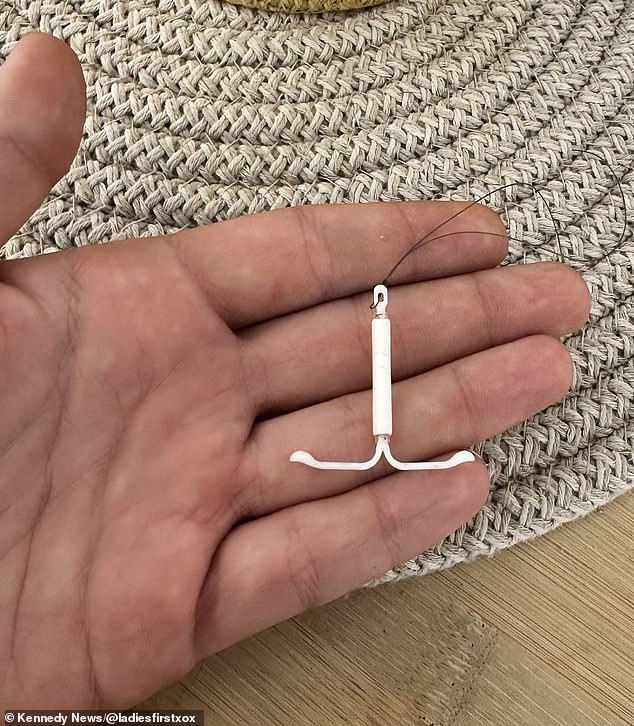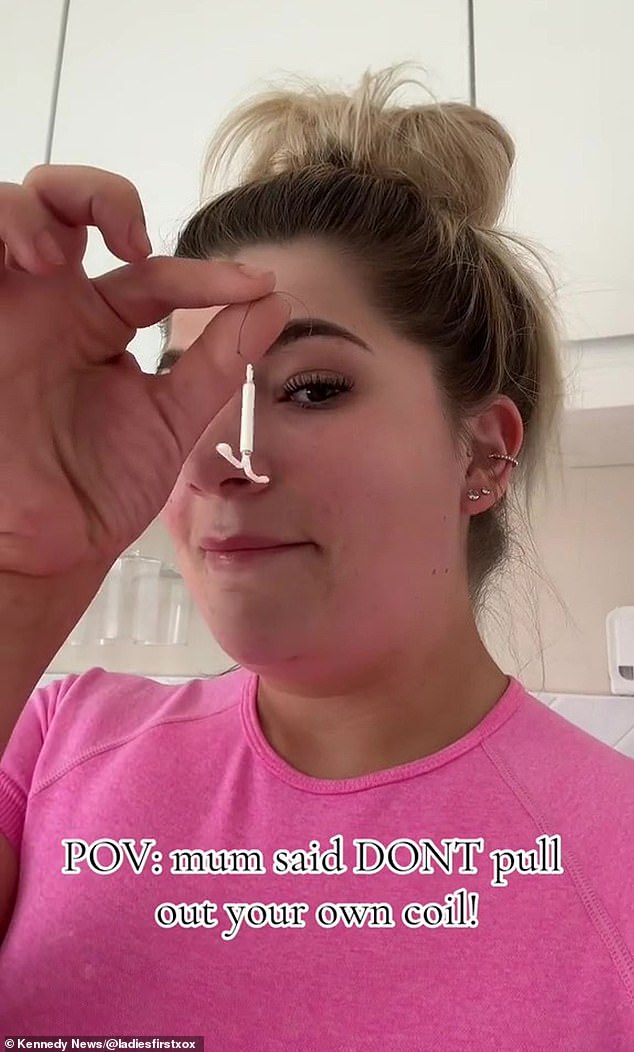Do not try this at home! Mother-of-two left in agony after being forced to pull out her own contraceptive coil when GP refused to offer an appointment
A desperate mum claims she was forced to remove her own IUD by hand after her GP told her they ‘didn’t have enough money’ for the procedure.
Kierra Platt, from Nuneaton in Warwickshire, had the contraceptive intrauterine device (IUD) fitted at the surgery last September after a nurse said it could help reduce her painful symptoms of endometriosis.
But within three weeks of it being inserted into the womb, she began experiencing agonizing pain, constant bleeding and even “constant anger.”
The 27-year-old went back to her GP for help, but claims she was told she would have to wait six months for her body to adjust to the contraception.
It was only in April, after four more appointments during which the mother-of-two sought help, that medics agreed to remove it.
Kierra Platt, from Nuneaton in Warwickshire, had the intrauterine device (IUD) fitted in the surgery last September on the advice of a nurse to reduce her painful symptoms of endometriosis. But within three weeks she began experiencing agonizing pain, constant bleeding and even “constant anger.”

The 27-year-old returned to her GP but claims she was told she would have to wait six months for her body to adjust to the contraception. Only in April, after four more appointments, did doctors agree to remove it. However, when booking a place, the mother of two says the receptionist advised her to go to a sexual health clinic or emergency room as the practice no longer offered family planning services.
But when the time finally came, Ms Platt said she was sent back to square one when the GP receptionist told her she needed to go to a sexual health clinic or urgent care because their practice no longer offered family planning services.
Unable to bear the wait for the clinic any longer, she took the drastic step of taking matters into her own hands and pulling it off herself.
Recalling her ordeal, she said: ‘Within three weeks of being on the coil, I noticed a change in my mood. I continued to bleed and stain and I found myself in constant rage.
“I had to put myself out there and take a moment and I was crying all the time. I thought I should give it some time to settle down and I thought it would be fine.
‘Occasionally, after I started experiencing these symptoms, I would tell the GP that something didn’t feel right and tell them I thought it was the IUD.
‘I told them I thought my symptoms were related to the IUD, but the doctor told me the hormones were in my cervix and therefore shouldn’t make me depressed.
‘I also started experiencing acne on the coil and this isn’t something I’ve had before.’
After pleading with her GP again in April to remove the IUD, she agreed but told Ms Platt she needed to make an appointment, she claimed.
‘I went to the receptionist but she said they no longer ran family clinics because they didn’t have the funding, so I couldn’t have it removed.’
She said the news left her “stunned.”
“I didn’t want to call emergency services and spend their time on something that could be removed in two seconds,” she said.
‘I needed it straight away because it was causing me a lot of stress, I couldn’t take any more of it.
‘I felt like I had no choice but to remove it myself. I felt helpless and like I was going crazy.’
The copper IUD prevents pregnancy by releasing copper ions into the uterus.
The copper changes the cervical mucus, making it harder for sperm to reach an egg and survive.
It can also prevent a fertilized egg from implanting.
Some experts have suggested that IUDs may help manage endometriosis symptoms because they inhibit ovulation, reduce the amount of estrogen in the body, and prevent endometrial tissue from growing.
The device – which has two small wires hanging so that women can check whether it is still in their vagina – only needs to be replaced after ten years.
More than a million women in Britain and 4.5 million in the US use the contraceptive IUD.
Around 45,000 Britons undergo the procedure to have one fitted every year.
But experts have long warned that access to the coil ‘varies’ from area to area, with waiting times for fittings stretching from four to more than 12 weeks in some NHS trusts.

She said: ‘I also started experiencing acne on the coil and this is not something I have suffered from before.’ After pleading with her GP again in April to remove the IUD, she agreed but told Ms Platt she needed to make an appointment, she claimed

Ms Platt said she was “not glorifying” the removal of do-it-yourself IUDs, a procedure recommended only by healthcare professionals. Instead, she had “no choice” because of the long wait
Doctors today also warned women not to remove them themselves, given the potential risk of infection from DIY extraction.
London-based NHS GP Dr Hana Patel told MailOnline: ‘I definitely don’t recommend removing it with the fingers as it could become twisted, stuck or cause uterine problems including cuts, bleeding and infections .
‘I am a general practitioner in women’s medicine and I remove and fit IUDs. It should absolutely be done by someone with relevant experience and qualifications.
‘A trained doctor or nurse can remove your IUD at any time.’
She added: ‘Check with your doctor to find out when your IUD needs to be removed or replaced.
‘It is possible to become pregnant once your IUD is removed.’
Ms Platt said she was “not glorifying” the removal of do-it-yourself IUDs, a procedure recommended only by healthcare professionals.
Instead, she insists she had “no choice” because of the long wait.
She added: ‘I lay down on my bed, put a pillow under my bum and just tried to see if I could feel the strings of my IUD.
‘I found the strings, which I was quite surprised about, because I didn’t think I could do that.
‘I grabbed it between my two fingers and started pulling and it felt like I was just pulling out a tampon.
‘I was astounded. I didn’t think it would be so easy to remove. I was in shock, but I was so relieved it was out.”
Now Ms Platt is urging others to demand answers from their doctors and not give up ‘if they think something is wrong’.
She said: ‘I knew I wasn’t the only one going through this with their health and I thought, ‘If I can help just one other person and show them they’re not alone,’ then that’s what I wanted to do.
‘After this experience I will never use hormonal contraception again.
‘If you have something in your body and you can’t get it removed, I think that’s terrible.
‘I have now also switched to another doctor’s practice.’
A spokesman for the practice said they cannot comment on the individual circumstances of the patient.
b
